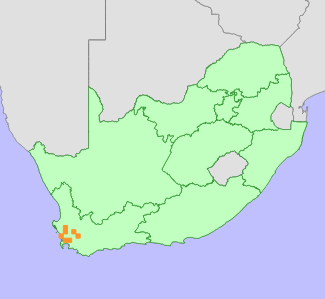|
Scientific Name | Aspalathus puberula (Eckl. & Zeyh.) R.Dahlgren |
Higher Classification | Dicotyledons |
Family | FABACEAE |
Synonyms | Aspalathus ericifolia L. subsp. puberula (Eckl. & Zeyh.) R.Dahlgren |
National Status |
Status and Criteria | Endangered B1ab(i,ii,iii,iv,v)+2ab(i,ii,iii,iv,v) |
Assessment Date | 2010/09/03 |
Assessor(s) | A.L. Schutte-Vlok & D. Raimondo |
Justification | This species has lost the majority (>80%) of its habitat to wheat and vineyard expansion, alien plant invasions and urban expansion. It remains threatened by lack of fire in renosterveld remnants and ongoing loss of habitat to urban expansion. Known from three locations, this species' current EOO is 337-450 km². |
Distribution |
Endemism | South African endemic |
Provincial distribution | Western Cape |
Range | Tygerberg to Darling. |
Habitat and Ecology |
Major system | Terrestrial |
Major habitats | Swartland Shale Renosterveld, Breede Shale Renosterveld, Swartland Granite Renosterveld |
Description | Clay soils in renosterveld vegetation. |
Threats |
| Agriculture was a severe past threat with over 94% of this species' habitat lost to ploughing and/or invasive alien plants.
Lack of fire due to fragmentation is a severe threat to many Aspalathus species as they require fire to recruit. All possible remaining locations for this species are highly isolated small fragments that landowners do not burn. It is very likely that the lack of burning of renosterveld fragments has resulted in this species disappearing from much of its range. |
Population |
There has been an 80% reduction in EOO due to loss of locations to crop cultivation and urban development. Decline is ongoing, for example a subpopulation was lost between 2008 and 2010 to development in the Malmesbury area.
|
Population trend | Decreasing |
Assessment History |
Taxon assessed |
Status and Criteria |
Citation/Red List version | | Aspalathus puberula (Eckl. & Zeyh.) R.Dahlgren | Critically Endangered (Possibly Extinct) | Raimondo et al. (2009) | |
Bibliography |
Dahlgren, R. 1965. Revision of the genus Aspalathus. II. The species with ericoid and pinoid leaflets. 4. The Aspalathus ericifolia, parviflora, calcarata, desertorum, macrantha, pinea, rostrata, filicaulis, laricifolia and longifolia groups. Opera Botanica 10(1):1-231.
Dahlgren, R. 1988. Crotalarieae (Aspalathus). In: O.A. Leistner (ed). Flora of southern Africa 16 Fabaceae, Part 3 Papilionoideae, Fascicle 6:1-430. National Botanical Institute, Pretoria.
Goldblatt, P. and Manning, J.C. 2000. Cape Plants: A conspectus of the Cape Flora of South Africa. Strelitzia 9. National Botanical Institute, Cape Town.
Raimondo, D., von Staden, L., Foden, W., Victor, J.E., Helme, N.A., Turner, R.C., Kamundi, D.A. and Manyama, P.A. 2009. Red List of South African Plants. Strelitzia 25. South African National Biodiversity Institute, Pretoria.
|
Citation |
| Schutte-Vlok, A.L. & Raimondo, D. 2010. Aspalathus puberula (Eckl. & Zeyh.) R.Dahlgren. National Assessment: Red List of South African Plants version 2024.1. Accessed on 2025/10/26 |
 Comment on this assessment
Comment on this assessment


